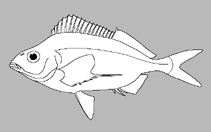| Family Cheilodactylidae - Morwongs | ||||
| Order | : | Centrarchiformes |

|
|
| Class | : | Teleostei | ||
| No. in FishBase | : | Genera : 1 | Species : 2 Eschmeyer's Catalog of Fishes | ||
| Environment | : | Fresh : No | Brackish : Yes | Marine : Yes | ||
| Division | : | Marine | ||
| Aquarium | : | none | ||
| First Fossil Record | : | |||
| Remark | : | Distribution: restricted to South Africa; temperate. Morphology: Body compressed and ovoid; mouth small, terminal to subterminal andlips large; eyes moderate size; two paits of nostrils with cirri on the lower pair of nostrils; frontal bone or maxilla without bony processes; teeth small, villiform in several rows, absent from vomer and palatines; Dorsal fin XVII-XX,19-25, single, |continuous with spines increasing in length up to sixth spine and decreasing onwards, the second is longest; Anal fin, III,9-11; pectoral fins 14 with ventral 4-5 thickened and unbranched; no gas bladder; supraneurals three, the first one preceeding first neural spine and the second and third supraneural between first and second neural spines (0/0+0/2+1/1/1; lateral line 75-85; scales small and cycloid; scaly sheath at base of dorsal and anal fins. Differs from Cirrhitidae by lacking cirri on dorsal spines (vs. present); differs from Cheilodactylidae and Aplodactylidae by the higher count of anal-fin rays and a more laterally compressed, deeper body; differs from Latridae by the missing gas bladder, by the late-stage larvae without the 'paperfish' stage and by the arrangement of the supraneurals with the first neural spine (Ref. 120445). Ecology: Feed on small benthic invertebrates. Hide in holes at night (Ref. 7463). Inhabits subtropical and temperate nearshore waters; often solitary, demersal over reef substrates (Ref. 76788). | ||
| Etymology | : | Greek, cheilos = lip + Greek, daktylos = finger ( Ref. 45335). | ||
| Reproductive guild | : | nonguarders | ||
| Typical activity level | : | normal | ||
Main Ref. |
: | Ludt, W.B., C.P. Burridge and P. Chakrabarty 2019 | ||
| Coordinator | : | |||
Deep Fin Classification

|
: | Osteichthyes | Actinopterygii | Actinopteri | Neopterygii | Teleostei | Osteoglossocephalai | Clupeocephala | Euteleosteomorpha | Neoteleostei | Eurypterygia | Ctenosquamata | Acanthomorphata | Acanthopterygii | Percomorphaceae | Eupercaria | | | Centrarchiformes | Cirrhitoidei | | Cheilodactylidae | ||
Important recommendation:
The list below must not be used as an authority reference synonymy list like those found in scientific published revisions, which must be the source to be used and cited eventually when they exist.
Rather, it reflects the current content of FishBase, and the progress with respect to synchronization with the Catalog of Fishes. However, we think it can be useful for users to assess the quality of information in FishBase, to start new work on the family, or to cross-check with other lists.
But we appreciate to be cited in publications when this list has been of any working value. In particular, for published scientific, we suggest then to cite it in the Material and Method section as a useful tool to conduct the research, but again, not as a taxonomic or nomenclatural authority reference.
Unless it is explicitly precised, the list is not complete, please search all original names published for the family in the Catalog of Fishes (genera, species), including those with uncertain or unknown status, that are not included in FishBase when they are not attached to a valid species.
This list uses some data from Catalog of Fishes (not shown but used to sort names).
The list ordered as follows:
Please send comments and corrections if you detect errors or missing names.
| Scientifc name | Status | Senior/Junior synonym | Combination |
|---|---|---|---|
Cheilodactylus fasciatus Lacepède, 1803 | accepted | senior | original |
Cheilodactylus multiradiatus Castelnau, 1861 | synonym | junior | original |
Cheilodactylus pixi Smith, 1980 | accepted | senior | original |